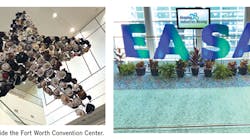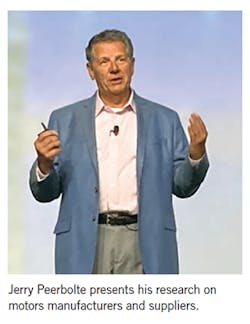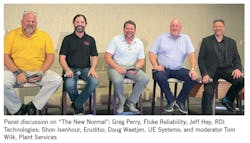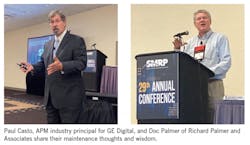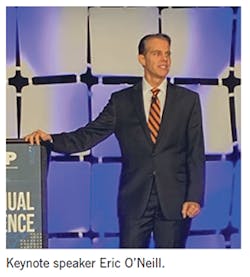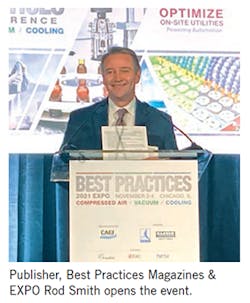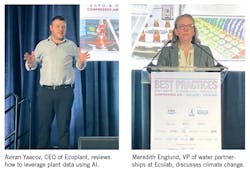EASA 2021 Convention • Fort Worth, TX • June 27-29 • www.easa.com/convention
The first in-person event on the Plant Services calendar this year was the EASA 2021 Convention, with a theme of Keeping Industries Moving. The highlights for me were the series of
professional talks held during the morning sessions over both days, as each talk addressed pressing issues facing the motors maintenance community.
The first talk was delivered by Ivan Campos, a research analyst with OMDIA (formerly IHS Markit), who presented a “Global Update on the Market for Electric Motors and Drives.” Some of the market trend insights he shared include:
- IE4 and IE5 motor efficiency benchmarks have been established, but there are no current plans to make motors meet those efficiency levels except in the European Union.
- As the adoption of IE3 and more efficient motors continues, the average price overall for motors will inflate.
- The average selling price of low voltage drives is increasing due to hikes in logistics costs and commodity fluctuations.
Campos also noted that the IIoT continues to be widely discussed, but it still experiencing a slow adoption rate. In fact in a 2021 OMDIA survey on digitization projects, respondents cited the following as their top three business challenges: (1) improving productivity, yield, or throughout; (2) improving sustainability; and (3) improving quality management. However, he noted that the most common ROI for industrial IIoT projects is found in maintenance, in areas such as improved OEE, reduced unplanned downtime, and increased labor efficiency.
The next day Jerry Peerbolte, assistant professor of marketing at the University of Arkansas – Fort Smith, presented his research on “Growing Your Business: Key Info from the Manufacturer / Supplier Community.” His study involved 31 interviews with executives at 17 companies, and each of the people he interviewed had praise for the relationship and value that EASA members bring to industry, a successful “trusted advisor” relationship with practitioners and vendors alike.
However, Peerbolte then outlined some significant ongoing market changes. On a technology level, he noted that plant teams currently consider any motors less than 75-100 hp as candidates for replacement rather than repair, when the bar used to be more around 50 hp. Peerbolte also noted the effect that web-based sales are having on the market, where differentiation has been defaulting to price rather than brand; in response, manufacturers are moving to online platforms to meet their audience there.
Most importantly, Peerbolte noted that while today the interest of plant teams lies with on-site condition monitoring, there will be a shift in focus over the next five years toward performance outcomes, where decision-making on a wide variety of maintenance decisions and services will be governed by fixed third-party contracts. This shift is already being driven by both the pandemic and by the challenge of recruiting full-time skilled maintenance technicians, and shows no sign of slowing.
Finally, it was my pleasure to meet Tom Bishop, P.E., in person and hear him deliver a presentation on “Repair Best Practices to Maintain Motor Efficiency & Reliability.” Drawing his talking points from ANSI/EASA AR100, as well as the Rewind Study Good Practice Guide, he broke his best practices into the following steps:
- Preliminary Inspection
- Dismantling
- Internal Inspection
- Winding Condition
- Rewinding
- Mechanical Repairs
- Testing To Confirm Integrity & Reliability of Repair.
The EASA 2022 Convention will take place in St. Louis next June 26-28. You can register at: https://easa.com/convention. –TW
2021 Leading Reliability Conference • Clearwater, FL • August 23-26 • www.leadingreliability.com
In August it was a return to the white beaches of Clearwater, Florida, for the inaugural in-person Leading Reliability Conference! A team of four partners – UE Systems, Eruditio, Fluke Reliability, and RDI Technologies – came together to explore and showcase the ways that complementary condition monitoring technologies support and drive reliability best practices.
The first two days of the conference featured workshops focused on motion amplification, lubrication, ultrasound, and reliability best practices, systems, and software, and were followed by two further days of learning sessions, case studies, and panel discussions. It was my honor to moderate one of the panel discussions, “The New Normal,” where the four panelists explored what’s in everyone’s toolkit and equipment locker in this current pandemic age, whether that toolkit has changed since March 2020 and whether it is likely to keep changing over the next 18 months.
Shon Isenhour, CMRP, CAMA and founding partner of Eruditio, conducted two very lively sessions. The first was on “Change Management and the COVID Change” during which he emphasized the growing importance of operator-based care as part of your organization’s maintenance strategy during the pandemic. With the frequency and length of COVID-related absences, operator-based care is growing in interest to help cover those absences. However, Isenhour warned, teams should understand that operator-based care requires a great deal of hidden support to train operators, and that maintenance teams need to get core processes in place first, such as planning, kitting, and maintaining the CMMS, before bringing operators onboard.
The next morning Isenhour held a debate session where he challenged the audience to take sides on a series of common points of argument, including: to kit, or not to kit? Should you implement reliability from the top-down or bottom-up? And exactly how many storeroom attendants does a plant need?
Another highlight of the week was the presentation “I Hate Being a Maintenance Scheduler, It’s Awesome” by Brian Hronchek, CMRP, who walked the audience through both the glory and pain associated with getting an organization onboard with a reliability program. His three steps: (1) find your opportunity for improvement—in his case, it was significant budget overruns which were mitigated by entering work into the CMMS and onto work orders; (2) identify your target audience—in his case, he thought it was the technicians, who all sort of ignored him, until he realized his real audience was his boss, and the most persuasive points centered on showing how they were losing money in the absence of improvements; (3) prepare for the change, in the form of doing the right leadership work once your program has been approved.
Finally, I have to note how impressive the keynote presenter was—Dan Cockerell, who spent 26 years working at Walt Disney World and retired as vice president of the Magic Kingdom. His presentation was titled “Maintaining The Magic,” and focused on the ways that, at Disney, “everything is measured and everything is hopefully predicted,” which taught him more and more about predictability and reliability every day. For example, he noted that when it comes to team building and program-building, “authorship instills ownership,” noting that when Disney built a cast-member app to centralize paycheck information, scheduling, etc., the cast member teams hated it—not because it didn’t work, but because they weren’t asked to be involved when it was designed. He also described the ways that Disney uses big data to improve the customer experience, from Magic Bands to shuttle buses schedules, observing that his job was to simultaneously ensure the satisfaction of the park guests while proving out the financial value of big data insights to Disney executives.
The next Leading Reliability event takes place in Clearwater, FL next May 10-12. You can register at: https://www.leadingreliability.com. –TW
SMRP 29th Annual Conference • St. Louis, MO • October 25-28 • www.smrp.org/events
In October, after almost a year and a half in the industry, I attended my first in-person industry conference. Like any trade show I’ve ever been to, it was a whirlwind, with more than I have time to see and more new names than I can remember without those handy business cards. Thanks to everyone I met this year, and if we didn’t meet, let’s plan for next time.
I got to meet face-to-face some of our columnists, whose work I’ve been editing for more than a year. Thanks to Shelia Kennedy, Doc Palmer, and Tom Moriarty for your great contributions and good in-person company. For me, there’s so many new things to learn everywhere I turn, it’s difficult to pick the best of what I saw because it’s all fresh to me.
Paul Casto, APM industry principal for GE Digital, reminded attendees that reliability, maintenance or asset management projects can fail without a good business plan. It’s easy to get caught up in the elegance of the solution and forget about the return on investment, he said. It’s one of the best tools for making the case to leadership for improvement projects.
Bruce Hawkins, senior maintenance and reliability consultant at Performance Consulting Associates Inc., discussed an in-depth reliability journey across a number of manufacturing plants. From a new CMMS and purchasing strategy to a move to predictive maintenance and a root cause analysis process, all those details can be overshadowed by the plant’s individual journey and the people on that journey. The plants achieved amazing business results, and Hawkins shared some of the lessons learned along the way. The biggest takeaway for me was the importance of culture and employee buy-in to your program, especially rolling out seven plants in one year. You need support from top to bottom.
If you haven’t yet heard of motion amplification or Jeff Hay, CEO of RDI Technologies, you’ll probably learn about it soon. The rapidly evolving technology uses a camera to visualize vibration that otherwise isn’t viewable to the naked eye. This “sensor of the future” is faster and safer and instead of complex charts and data, users get video data. The video is something almost other-worldly, or perhaps something maintenance professionals aren’t supposed to so easily view, like peeking behind the curtain.
Finally, I can’t end without a comment about the keynote speaker, Eric O’Neill of The Georgetown Group and former FBI agent. His story had it all—movie clips staring Ryan Phillippe and Laura Linney, Russian spies, cyber criminals, stealing data from a Palm pilot in just in time fashion, and USB drives hidden in peanut butter sandwiches. I am admittedly on my second book about Robert Hanssen, the FBI counterintelligence agent that traded secrets to Russia for more than 20 years.
Cybersecurity used to just be an issue for government intelligence officials or only the largest companies, and while the story of our country’s first cybercriminal was nothing short of fantastic (in a “how did that happen” kind of way), cybercrime is no longer a distant invader for manufacturers. While the threat isn’t likely insider double agents, ransomware attacks are affecting more and more small- to medium-sized manufacturers. And increased use of digital technology requires more cybersecurity for data storage and the systems. –AT
Best Practices 2021 EXPO & Conference • Schaumburg, IL • November 2-4 • www.cabpexpo.com
After a virtual event in 2020, the Compressed Air Best Practices Expo returned to an in-person conference Nov. 1-4. The mornings included two different education tracks (Compressed Air Reliability, Automation & Efficiency; and Cooling Systems, Vacuum, Aeration Blowers & Compressed Air Safety) followed by full group plenary sessions the first two days. Compressed Air Challenge Training and Compressed Air and Gas Institute (CAGI) certified compressed air system specialist (CCASS) testing took place in the afternoons.
The conference and expo is hosted by Compressed Air Best Practices magazine, which provides educational content about compressed air systems to help energy managers create industrial energy savings. As the media company expanded its coverage from compressed air to cooling systems, blowers and vacuums, this conference is also an attempt to bring those industries together. “We’re bringing in experts from the cooling world and trying to break down those silos for the benefit of the end customer,” said Rod Smith, publisher of Best Practices magazines and Expo.
While the education continues to focus on basic concepts for compressed air management—how to use less and be more efficient—the market is also reacting to climate change issues that are influencing corporate sustainability goals, touching plant floors and compressed air systems more and more.
Chad Larrabee, education committee chair at CAGI, which represents manufacturers of air and gas compressors, blowers and vacuums, compressed air and gas dryer equipment, and nitrogen generation equipment, echoed the message about industry education. “Compressed air and the use of pneumatics, it was part of the industry revolution and its influence on manufacturing and even mining and infrastructure, it spans about 150 years. And whether compressed air is used as an ingredient in a process or as a mode of force, pneumatics, it touches just about everything that’s made,” Larrabee said.
In addition to publishing standards for and working with the government on behalf of the compressed air industry, the organization also provides educational opportunities to promote cooperation and safety in the industry. Larrabee said CAGI recently revamped its e-learning program.
The opening session concluded with a look at how climate change issues and corporate sustainability is affecting utility use in plants. Meredith Englund, vice president of water partnerships at Ecolab, works at the intersection of sustainability, strategy and business development. Ecolab operates primarily in water infection prevention and hygiene, helping industrial customers with its water needs.
Englund discussed the convergence of two tipping points: industrial sustainability goals and digital plant technology using artificial intelligence to improve operations or maintenance. She also outlined the latest global climate change goals, what that means for industry, and innovative ways industry is meeting those challenges with technology.
In 2018, global climate scientists released the Intergovernmental Panel on Climate Change (IPCC) report with data and timelines for the needed cuts in emissions. This outlined the concept of net zero emissions. To stay within the needed global warming limit of 1.5 °C, the whole world needs to get to net zero by 2050 and halfway by 2030.
“The biggest impact that that has really had has been on corporate sustainability goals,” Englund said. Net zero also applies to water resources, which are often part and parcel with electricity and compressed air needs in a factory system, and industry has lofty goals to meet through carbon emissions reduction. They are meeting these challenges, Englund said, by setting plant level targets, setting aside dedicated capital funds for sustainability, carbon pricing savings, and technology innovation. Englund works most in the latter category.
“As Ecolab has innovated internally around water systems within a plant, we’ve also been looking externally at what’s the best innovation out there in other areas, and that’s where we came across Ecoplant and what they’re doing with compressed air.”
Aviran Yaacov, CEO of Ecoplant, encouraged attendees to think about compressed air as not only a system, but also a process—one you operate and maintain like any other process, including on supply and demand side. Ecoplant improves the compressed air process by leveraging plant data and using AI to aggregate all the data, learn the processes and make decisions in real-time.
The plenary session the second day echoed theme from the first day about systems and technology, including many education track sessions on other parts of the compressed air system and innovative tech. At the plenary session, Tom Taranto, owner of Data Power Services discussed several case studies that demonstrated the benefits from a compressed air system assessment that considers the entire system—from energy inputs to the work performed.
Technology remained a theme, as Elhay Farkash, CEO of Zira Group, discussed the work he’s doing with California dairy farms, using artificial intelligence to drive energy conservation.
That’s just a small part of the education sessions from this year. The next conference will take place October 4-6, 2022 at the Cobb Galleria Centre Atlanta in Georgia. –AT
This story originally appeared in the December 2021 issue of Plant Services. Subscribe to Plant Services here.
